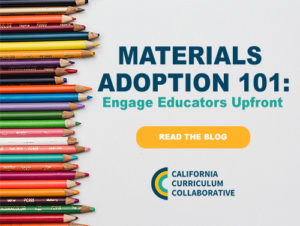Blog
Materials Adoption 101: Engage Educators Upfront
November 16, 2018


If your district is adopting new science instructional materials this school year, you already know there are a million things to consider as you get started: how the Next Generation Science Standards (NGSS) Innovations are expected to appear in materials, which programs to investigate, how to measure the quality of those programs, and who to include in the decision-making process.
At CalCurriculum we’ve developed some key actions to ensure a successful adoption process which can help guide districts from start to finish. One of those actions includes engaging educators throughout the process with clear roles for how they can and should participate in selection. Not only do teachers have unique expertise in working with science materials, but including them ensures compliance with California’s requirements and builds broader support for your adoption decisions.
From our work in California, we’ve seen some districts excel at engaging teachers in meaningful ways and have come to know that this almost always begins with involving them in the process as early as possible. Here are a few best practices to get started:
INCLUDE EDUCATORS ON THE ADOPTION COMMITTEE (with real roles and responsibilities)
- Know Who Needs to be at the Table: Be thoughtful about what your needs are and what the various stakeholders can bring to the table. Conduct a needs assessment and consider what your data reveals at both the district and school level. This is critical to deciding who is necessary for your committee and what role they should play.
- Ensure Diverse Perspectives: A diversity of perspectives and expertise (multiple grade-levels, content areas, priority specialists, etc) will help ensure that as instructional materials are selected all students’ needs are considered. This includes teachers who may not have a strong background in science, which would lead your team to consider the professional learning needs of your educators and how the materials can support them.
- Have a Game Plan: How will you establish roles and responsibilities? How will you set clear expectations? What will the group be doing together? How can you develop a shared vocabulary and understanding of the characteristics of quality instructional materials? How will you encourage active participation? And most of all, how can you ensure that the educators on the committee will be actively communicating with their school sites?
Including educator knowledge and expertise increases the quality of the selection process and having those voices actively sharing information with colleagues bolsters the adoption’s credibility, which builds buy-in for your rollout and implementation of the materials.
SURVEY TEACHERS (and listen to what they tell you)
- Get Input Upfront: Conduct district-wide surveys. The information from these surveys can be invaluable and help inform the adoption process from the beginning. Types of questions you might consider include: what is your current understanding of the NGSS and Innovations? What is your experience with the previous science adoption? What do our current instructional materials do well? Where can our current materials be improved? What do you value in science materials?
- Inclusion Matters: Not every teacher will need to be a member of the adoption committee, but leaders should ensure that every single teacher has a real venue to share their voice. This can later prove to be crucial for buy-in around the materials that are selected.
We know that districts will have to tailor and choose approaches that makes sense for them, but the overarching principle remains the same: prioritize some kind of mechanism to solicit educator feedback and make sure to apply what you’re hearing in real time.
EDUCATOR VOICE MATTERS
Ultimately, teachers are solely responsible for delivering whatever instructional materials a district decides to choose. For this reason alone, their experiences and expertise should inform what is selected. Bringing those educators into the process early on, with many opportunities to fully participate in the decision-making, can help guarantee a successful rollout and further support the implementation of those materials. What’s more, including educator voices will ensure that the needs of students stay front and center, and that the science they learn in school will truly prepare them for college and career.